Abstract
A previous study from this laboratory (D. P. Snider, D. Skea, and B. J. Underdown, Infect. Immun. 56:2838-2842, 1988) indicated that immunodeficient mice expressing the xid gene develop prolonged infections with Giardia muris, unlike immunocompetent mice, which eliminate the intestinal protozoan parasite in 8 to 10 weeks. In this study, CBA/N (xid) and CBA/Ca mice were infected with G. muris cysts and at various times following this primary infection were cured by treatment with metronidazole. In contrast to the marked differences in the ability of xid and normal mice to eliminate a primary infection, mice of both strains were resistant to a secondary challenge of G. muris cysts. These data imply that the mechanism(s) responsible for elimination of a primary infection is not identical to those required to resist a secondary challenge infection. Splenocytes from immunocompetent CBA/Ca mice (but not immunodeficient CBA/N mice) could transfer the ability to eliminate a primary G. muris infection to irradiated mice of either strain. In contrast, splenocytes from previously infected CBA/Ca mice could not transfer resistance to a challenge infection, further supporting the hypothesis that there are differences between mechanisms required to eliminate a primary infection and those necessary to resist a second challenge infection.
Full text
PDF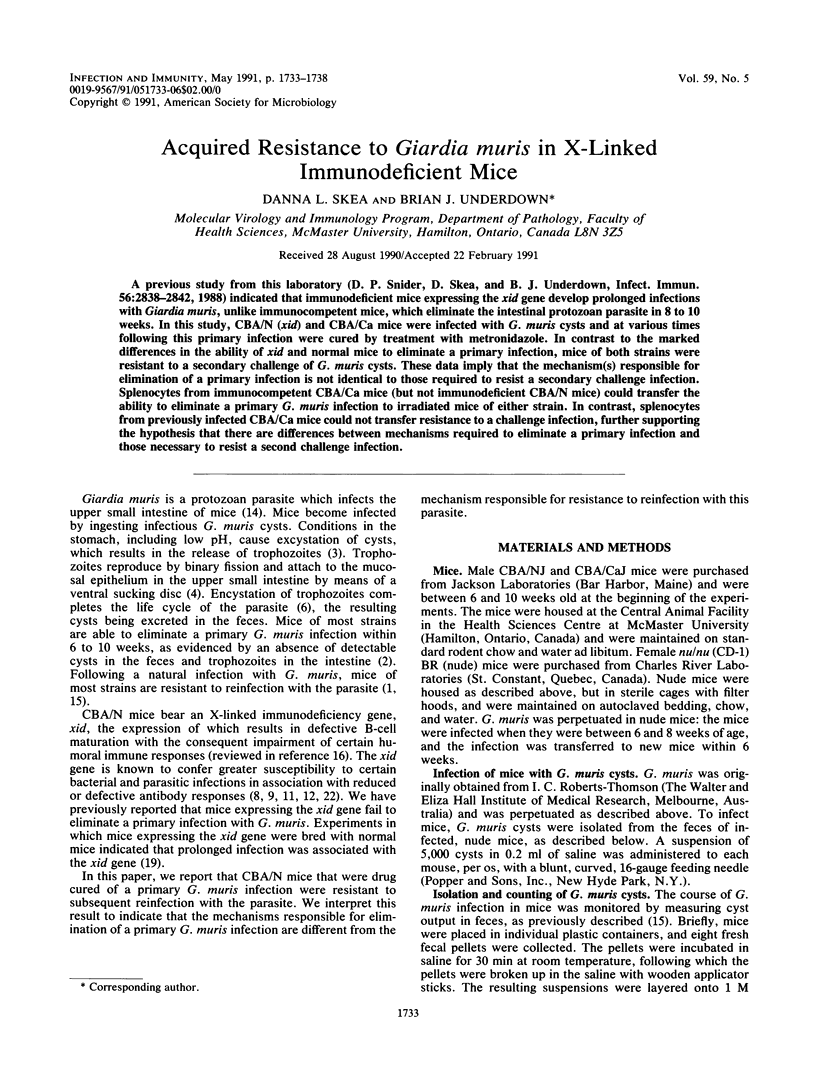
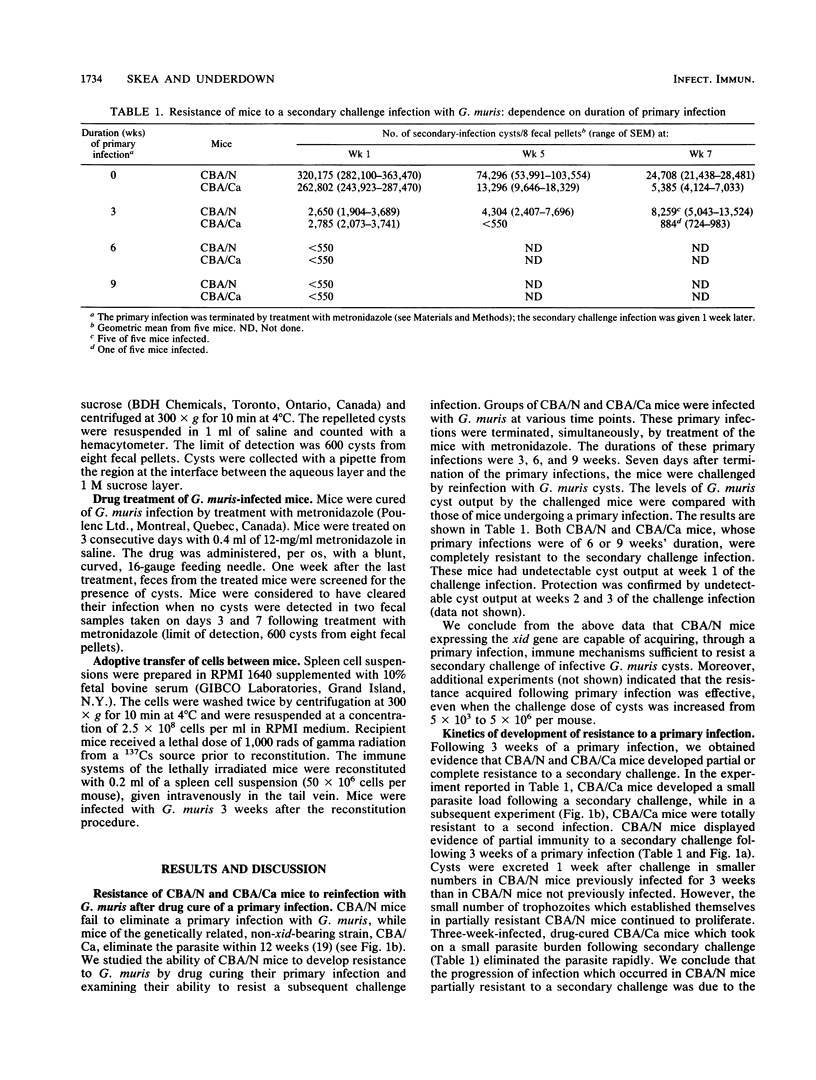
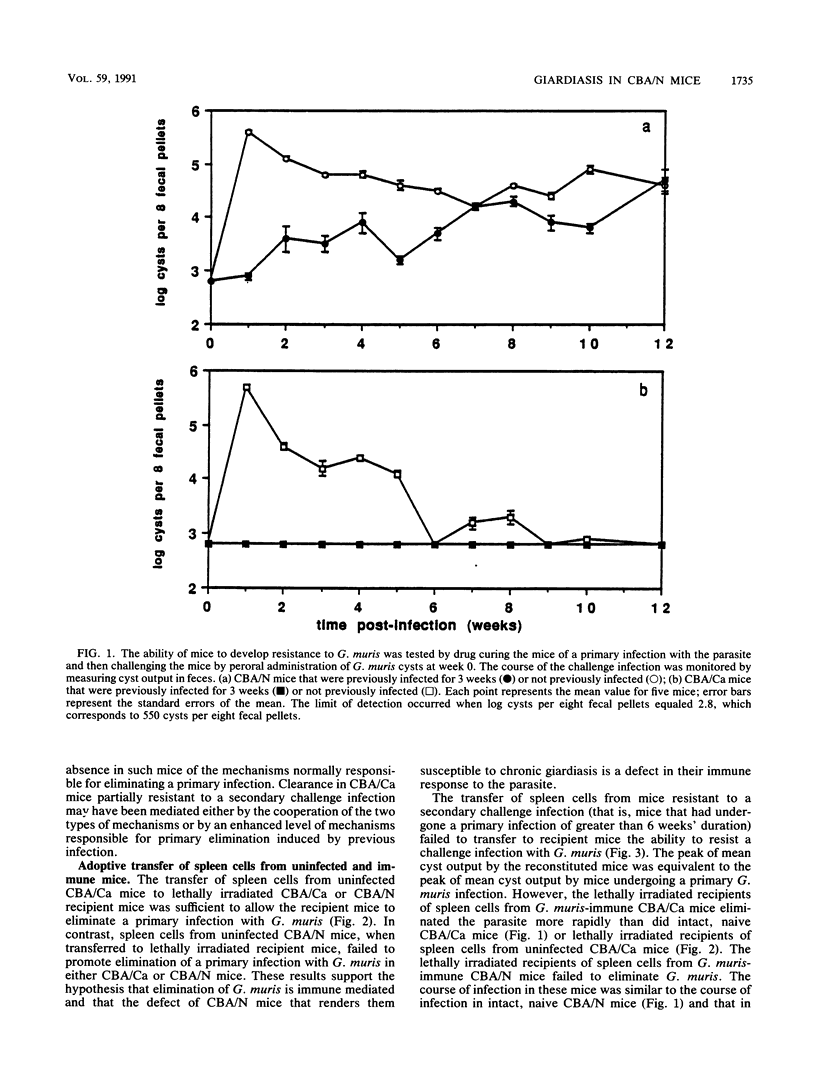
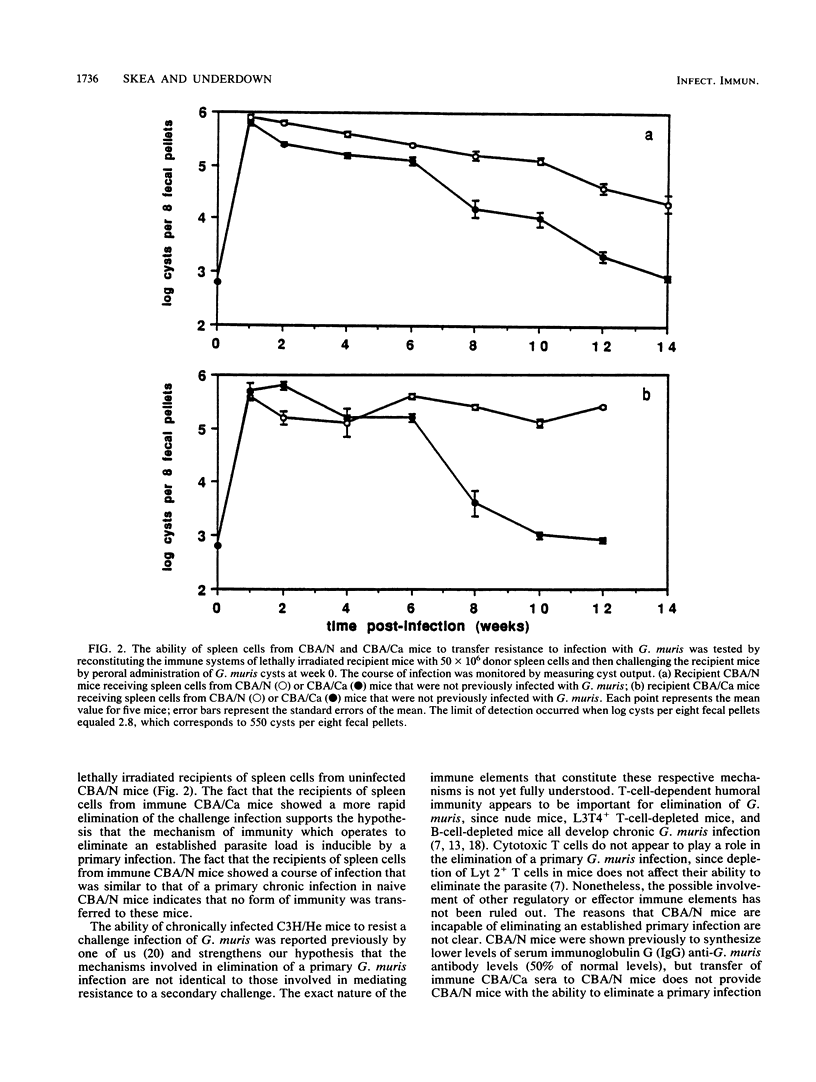
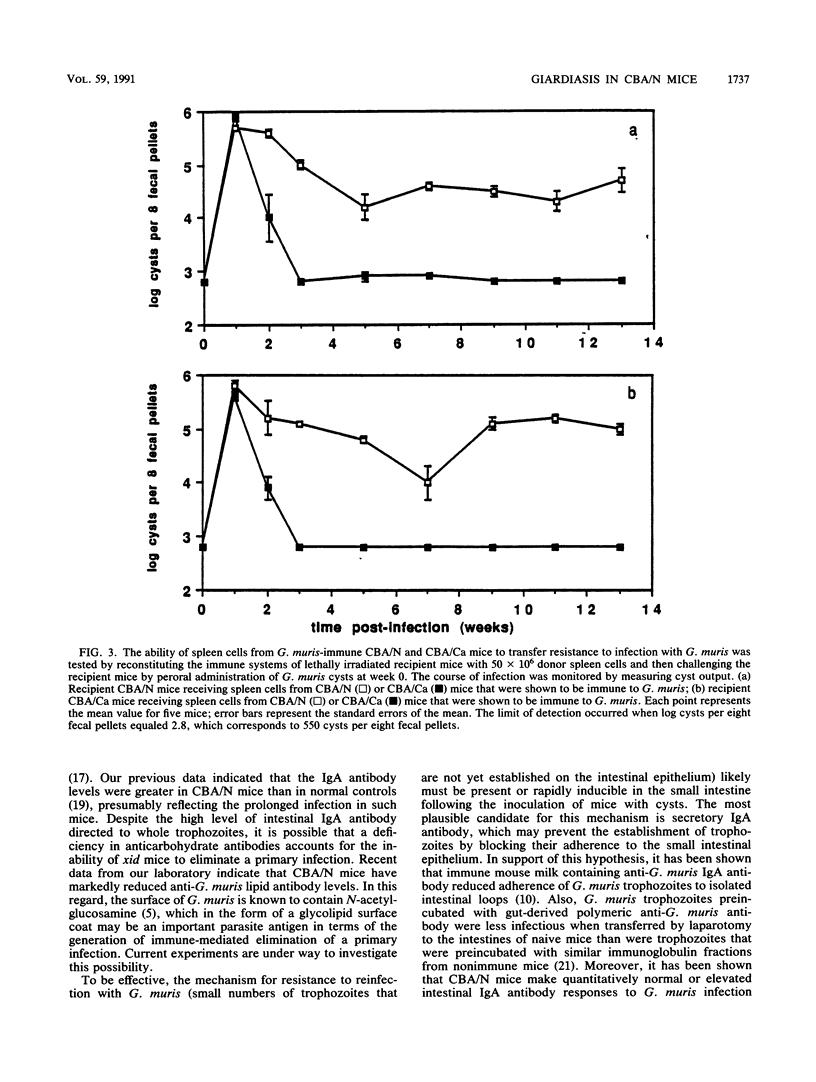
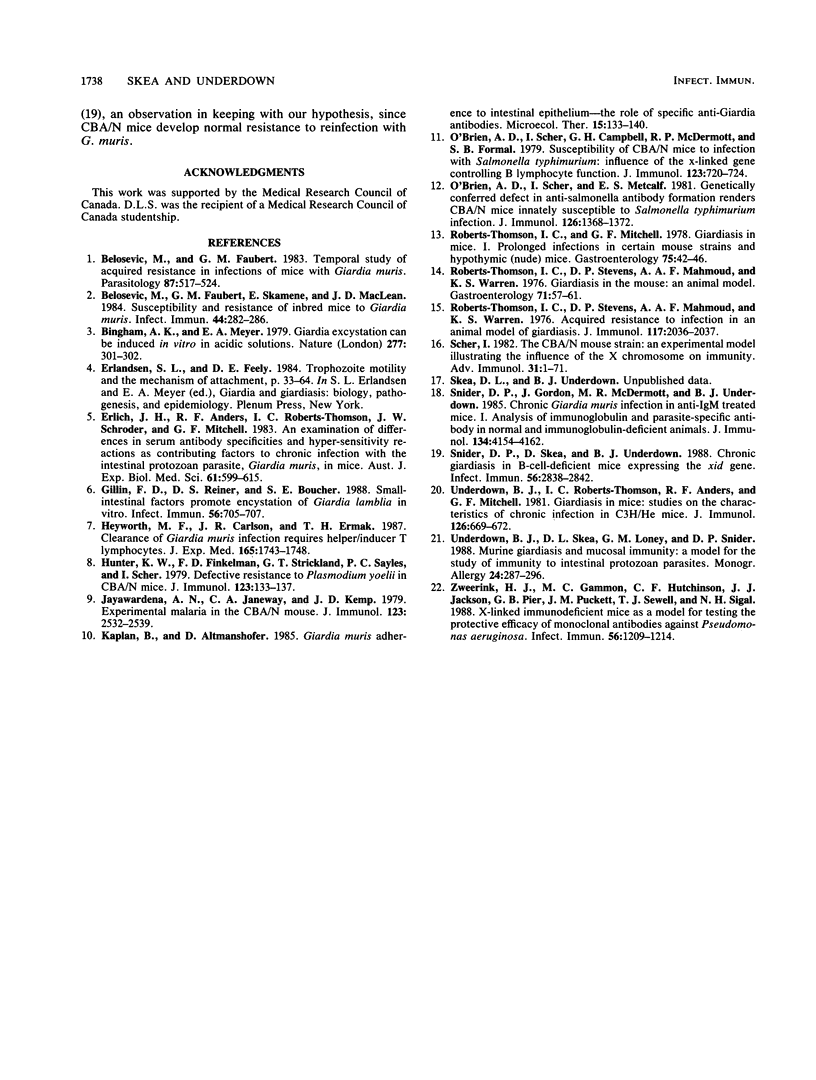
Selected References
These references are in PubMed. This may not be the complete list of references from this article.
- Belosevic M., Faubert G. M., Skamene E., MacLean J. D. Susceptibility and resistance of inbred mice to Giardia muris. Infect Immun. 1984 May;44(2):282–286. doi: 10.1128/iai.44.2.282-286.1984. [DOI] [PMC free article] [PubMed] [Google Scholar]
- Belosevic M., Faubert G. M. Temporal study of acquired resistance in infections of mice with Giardia muris. Parasitology. 1983 Dec;87(Pt 3):517–524. doi: 10.1017/s0031182000083037. [DOI] [PubMed] [Google Scholar]
- Bingham A. K., Meyer E. A. Giardia excystation can be induced in vitro in acidic solutions. Nature. 1979 Jan 25;277(5694):301–302. doi: 10.1038/277301a0. [DOI] [PubMed] [Google Scholar]
- Erlich J. H., Anders R. F., Roberts-Thomson I. C., Schrader J. W., Mitchell G. F. An examination of differences in serum antibody specificities and hypersensitivity reactions as contributing factors to chronic infection with the intestinal protozoan parasite, Giardia muris, in mice. Aust J Exp Biol Med Sci. 1983 Oct;61(Pt 5):599–615. doi: 10.1038/icb.1983.57. [DOI] [PubMed] [Google Scholar]
- Gillin F. D., Reiner D. S., Boucher S. E. Small-intestinal factors promote encystation of Giardia lamblia in vitro. Infect Immun. 1988 Mar;56(3):705–707. doi: 10.1128/iai.56.3.705-707.1988. [DOI] [PMC free article] [PubMed] [Google Scholar]
- Heyworth M. F., Carlson J. R., Ermak T. H. Clearance of Giardia muris infection requires helper/inducer T lymphocytes. J Exp Med. 1987 Jun 1;165(6):1743–1748. doi: 10.1084/jem.165.6.1743. [DOI] [PMC free article] [PubMed] [Google Scholar]
- Hunter K. W., Jr, Finkelman F. D., Strickland G. T., Sayles P. C., Scher I. Defective resistance to Plasmodium yoelii in CBA/N mice. J Immunol. 1979 Jul;123(1):133–137. [PubMed] [Google Scholar]
- Jayawardena A. N., Janeway C. A., Jr, Kemp J. D. Experimental malaria in the CBA/N mouse. J Immunol. 1979 Dec;123(6):2532–2539. [PubMed] [Google Scholar]
- O'Brien A. D., Scher I., Campbell G. H., MacDermott R. P., Formal S. B. Susceptibility of CBA/N mice to infection with Salmonella typhimurium: influence of the X-linked gene controlling B lymphocyte function. J Immunol. 1979 Aug;123(2):720–724. [PubMed] [Google Scholar]
- O'Brien A. D., Scher I., Metcalf E. S. Genetically conferred defect in anti-Salmonella antibody formation renders CBA/N mice innately susceptible to Salmonella typhimurium infection. J Immunol. 1981 Apr;126(4):1368–1372. [PubMed] [Google Scholar]
- Roberts-Thomson I. C., Mitchell G. F. Giardiasis in mice. I. Prolonged infections in certain mouse strains and hypothymic (nude) mice. Gastroenterology. 1978 Jul;75(1):42–46. [PubMed] [Google Scholar]
- Roberts-Thomson I. C., Stevens D. P., Mahmoud A. A., Warren K. S. Acquired resistance to infection in an animal model of giardiasis. J Immunol. 1976 Nov;117(5 PT2):2036–2037. [PubMed] [Google Scholar]
- Roberts-Thomson I. C., Stevens D. P., Mahmoud A. A., Warren K. S. Giardiasis in the mouse: an animal model. Gastroenterology. 1976 Jul;71(1):57–61. [PubMed] [Google Scholar]
- Scher I. The CBA/N mouse strain: an experimental model illustrating the influence of the X-chromosome on immunity. Adv Immunol. 1982;33:1–71. doi: 10.1016/s0065-2776(08)60834-2. [DOI] [PubMed] [Google Scholar]
- Snider D. P., Gordon J., McDermott M. R., Underdown B. J. Chronic Giardia muris infection in anti-IgM-treated mice. I. Analysis of immunoglobulin and parasite-specific antibody in normal and immunoglobulin-deficient animals. J Immunol. 1985 Jun;134(6):4153–4162. [PubMed] [Google Scholar]
- Snider D. P., Skea D., Underdown B. J. Chronic giardiasis in B-cell-deficient mice expressing the xid gene. Infect Immun. 1988 Nov;56(11):2838–2842. doi: 10.1128/iai.56.11.2838-2842.1988. [DOI] [PMC free article] [PubMed] [Google Scholar]
- Underdown B. J., Roberts-Thomson I. C., Anders R. F., Mitchell G. F. Giardiasis in mice: studies on the characteristics of chronic infection in C3h/He mice. J Immunol. 1981 Feb;126(2):669–672. [PubMed] [Google Scholar]
- Underdown B. J., Skea D. L., Loney G. M., Snider D. P. Murine giardiasis and mucosal immunity: a model for the study of immunity to intestinal protozoan parasites. Monogr Allergy. 1988;24:287–296. [PubMed] [Google Scholar]
- Zweerink H. J., Gammon M. C., Hutchison C. F., Jackson J. J., Pier G. B., Puckett J. M., Sewell T. J., Sigal N. H. X-linked immunodeficient mice as a model for testing the protective efficacy of monoclonal antibodies against Pseudomonas aeruginosa. Infect Immun. 1988 May;56(5):1209–1214. doi: 10.1128/iai.56.5.1209-1214.1988. [DOI] [PMC free article] [PubMed] [Google Scholar]


